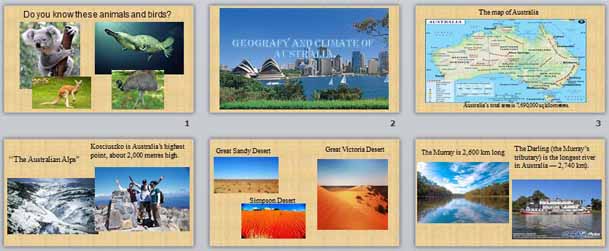Цель: развитие коммуникативных и лексико - грамматических навыков и умений по теме “Geography and climate of Australia”.
Задачи:
учебная: совершенствовать навыки самостоятельного чтения с извлечением специальной информации;
развивающая: развивать способности учащихся логически правильно и грамотно излагать свои мысли по теме;
воспитательная: воспитывать уважительное отношение к культуре страны;
познавательная: расширить знания страноведческого характера в рамках предъявленной темы.
Оборудование: карта Австралии, раздаточный материал для учащихся (тексты об Австралии), компьютерные презентации по теме “Geography and climate of Australia”” и “Animals and birds of Australia”.
I. Начало урока. Приветствие.
- Good morning. I am glad to see you at our lesson.
II. Постановка цели.
- Today we are going to make our trip to the country, which is called an upside - down world. Do you know what country is called so? Only here you can meet unusual animals and birds. (приложение 1, слайд 1) You are right. The name of this country is AUSTRALIA!
III. Основная часть урока
- Auding.
Do you know why Australia is called an upside - down world.
Now listen to the text and find the information, which explains this. (приложение 2)
Pupil 1: It is called so, because New Year is in the middle of summer.
Pupil 2: It is called so, because the middle of winter is in June.
Pupil 3: It is called so, because hot winds blow from the north.
Pupil 4: It is called so, because cold winds blow from the south.
- Answer some more questions about Australia.
- Before reading the text about Australia I want to find out what you know about this continent.
- Where is this continent situated? (It is located between the Indian Ocean and the South Pacific Ocean. )
- What is the capital of Australia? (Canberra)
- Which is a popular Australian animal? (kangaroo)
- Who are the Australian natives? (Aborigines)
- Who discovered Australia? (Captain James Cook)
- What is the official Language in Australia? (English)
- Reading
- Thank you for your answers. And now I invite you to travel to this continent. Let’s listen to the information. (приложение 1, слайды 2 - 11)

The Commonwealth of Australia
Pupil 1 The Commonwealth of Australia is formed of Australia, Tasmania and several smaller islands.
Australia itself is made up of the mainland of Australia and the island of Tasmania in the South. It is located between the Pacific and the Indian oceans in the Southern Hemisphere.
Australia is the only country in the world which has the territory of the whole continent. Australia’s total area is 7, 690, 000 sq kilometres.
Its main mountain chain is the Great Dividing Range which is known as "the Australian Alps". It runs along the western coast. Australia’s highest point, Kosciuszko in the Australian Alps is only about 2, 000 metres high.
Pupil 2 Australia is very dry. In the centre of the continent there are three deserts: Great Sandy Desert, Great Victoria Desert and Simpson Desert. In fact, Great Sandy and Great Victoria Deserts are among the largest deserts in the world.
There are not so many rivers and lakes in Australia. Its best known rivers are:
— the Murray (2, 600 km long);
—the Darling (the Murray’s tributary; is the longest river in Australia — 2, 740 km).
Massive salt lakes are often dry for long periods. They are fed by a large river system which carries water to fill them. The largest lake is Lake Eyre.
Climate
Pupil 3 Because of Australia’s great size there are different climatic regions here. The climate of Australia ranges from tropical in the North, to cool temperate in the south - east where it even often snows in winter.
There are such weather hardships in Australia as droughts, floods and cyclones along its coasts.
The continent suffers from the lack of fresh water. South Australia is the driest state of the driest continent on the Earth.
Pupil 4 The isolated geographical position of Australia had great influence on its fauna and flora. Australia is a land of birds and animals which can not be found anywhere else in the world.
The most peculiar feature of Australian animals is the pouch (that is a kind of a pocket). The best known of them are the kangaroo and the koala bear.
The kangaroo is a marsupial animal, i. e. an animal that carries babies in the pouch for eight months. It is the largest marsupial in the world. It can weigh 85 kilogrammes.
Why a "kangaroo"? When European explorers first saw these strange hopping animals they asked a native Australian Aborigine about their name. He answered "kangaroo" to say "I don’t understand your question".
The explorers thought this was the animal’s name. That is how the kangaroo got its name.
Pupil 5 The koala is a small bear - like animal which lives in the eucalyptus trees. Most of its time the koala spends in these trees sleeping. Koala has a black nose and thick furry coat. It can weigh 10 kilogrammes. The koala’s nickname is a "native bear". But it is not even related to bears. The koala is
related to the kangaroo and the wombat. The name "koala" is the Aboriginal name for "no water".
Pupil 6 The emu is a large bird which runs well but cannot fly. The emu and the kangaroo are represented at the emblem of Australia.
The kookaburra is a popular Australian bird that sounds like a human laughing.
Pupil 7 Though the emu and the kangaroo are symbols of Australia, but a sheep merino, which is famous for its fine wool also symbolizes the country. There is even a monument to the sheep in one of the Australian cities.
Because Australian climate is good for sheep - farming there are a lot of sheep farms (called "sheep stations") in many parts of the country where wool is produced for export. There are around 150 million of sheep.
Pupil 8 In the North there are tropical forests, in the north - east there are savannahs and grassland, in the south - east there are forests of eucalyptus or other ever - green trees which never lose their leaves, even in winter.
Some plants cannot be found in other parts of the world either. They are endemic. Its main native plants are wattle (or acacia), eucalyptus (or gum), mulga (mimosa), palm, fern and cedar.
Весь материал - смотрите документ.

 Получите свидетельство
Получите свидетельство Вход
Вход












 Конспект и презентация по английскому языку "Geography and climate of Australia" (9.08 MB)
Конспект и презентация по английскому языку "Geography and climate of Australia" (9.08 MB)
 0
0 1698
1698 443
443 Нравится
0
Нравится
0


